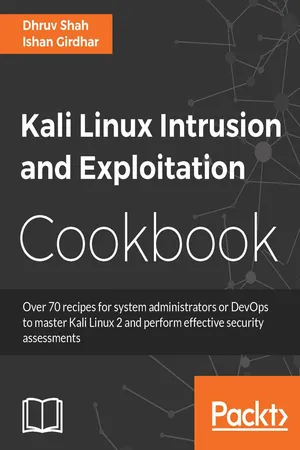
- 512 pages
- English
- ePUB (mobile friendly)
- Available on iOS & Android
Kali Linux Intrusion and Exploitation Cookbook
About This Book
Over 70 recipes for system administrators or DevOps to master Kali Linux 2 and perform effective security assessmentsAbout This Book• Set up a penetration testing lab to conduct a preliminary assessment of attack surfaces and run exploits• Improve your testing efficiency with the use of automated vulnerability scanners• Work through step-by-step recipes to detect a wide array of vulnerabilities, exploit them to analyze their consequences, and identify security anomaliesWho This Book Is ForThis book is intended for those who want to know more about information security. In particular, it's ideal for system administrators and system architects who want to ensure that the infrastructure and systems they are creating and managing are secure. This book helps both beginners and intermediates by allowing them to use it as a reference book and to gain in-depth knowledge.What You Will Learn• Understand the importance of security assessments over merely setting up and managing systems/processes• Familiarize yourself with tools such as OPENVAS to locate system and network vulnerabilities• Discover multiple solutions to escalate privileges on a compromised machine• Identify security anomalies in order to make your infrastructure secure and further strengthen it• Acquire the skills to prevent infrastructure and application vulnerabilities• Exploit vulnerabilities that require a complex setup with the help of MetasploitIn DetailWith the increasing threats of breaches and attacks on critical infrastructure, system administrators and architects can use Kali Linux 2.0 to ensure their infrastructure is secure by finding out known vulnerabilities and safeguarding their infrastructure against unknown vulnerabilities.This practical cookbook-style guide contains chapters carefully structured in three phases – information gathering, vulnerability assessment, and penetration testing for the web, and wired and wireless networks. It's an ideal reference guide if you're looking for a solution to a specific problem or learning how to use a tool. We provide hands-on examples of powerful tools/scripts designed for exploitation.In the final section, we cover various tools you can use during testing, and we help you create in-depth reports to impress management. We provide system engineers with steps to reproduce issues and fix them.Style and approachThis practical book is full of easy-to-follow recipes with based on real-world problems faced by the authors. Each recipe is divided into three sections, clearly defining what the recipe does, what you need, and how to do it. The carefully structured recipes allow you to go directly to your topic of interest.
Frequently asked questions
Information
Building a Classification Model with Spark *


- Predicting the probability of Internet users clicking on an online advert; here, the classes are binary in nature (that is, click or no click)
- Detecting fraud; again, in this case, the classes are commonly binary (fraud or no fraud)
- Predicting defaults on loans (binary)
- Classifying images, video, or sounds (most often multiclass, with potentially very many different classes)
- Assigning categories or tags to news articles, web pages, or other content (multiclass)
- Discovering e-mail and web spam, network intrusions, and other malicious behavior (binary or multiclass)
- Detecting failure situations, for example, in computer systems or networks
- Ranking customers or users in order of probability that they might purchase a product or use a service
- Predicting customers or users who might stop using a product, service, or provider (called churn)
- Discuss the types of classification models available in ML library
- Use Spark to extract appropriate features from raw input data
- Train a number of classification models using ML library
- Make predictions with our classification models
- Apply a number of standard evaluation techniques to assess the predictive performance of our models
- Illustrate how to improve model performance using some of the feature-extraction approaches fromChapter 3,Obtaining, Processing, and Preparing Data with Spark
- Explore the impact of parameter tuning on model performance, and learn how to use cross-validation to select the most optimal model parameters
Types of classification models
Linear models
Table of contents
- Title Page
- Copyright
- Credits
- About the Authors
- About the Reviewers
- www.PacktPub.com
- Customer Feedback
- Preface
- Getting Started - Setting Up an Environment
- Network Information Gathering
- Network Vulnerability Assessment
- Network Exploitation
- Web Application Information Gathering
- Building a Classification Model with Spark *
- Web Application Vulnerability Assessment
- Web Application Exploitation
- System and Password Exploitation
- Privilege Escalation and Exploitation
- Wireless Exploitation
- Pen Testing 101 Basics